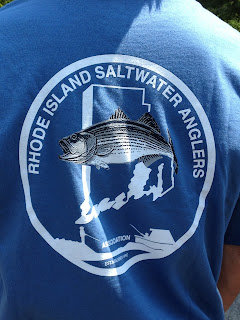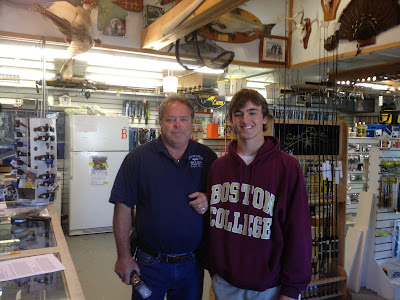It's four oclock in the morning on
Friday May 31st and I hear my alarm ringing off the hook. After four hours of restless sleep I find myself fully awake with butterflies in my stomach and my mind racing with excitement. This was the morning of the charter! After a quick bagel and shot of orange juice for breakfast we were off and driving to Breachway Bait and Tackle. Captain Mouchon was going to take my grandfather and me out on a fishing charter out of Charlestown Breachway. We were finally going to learn some of his favorite spots and techniques which have brought in countless numbers of large striped bass!

By 4:50 a.m we were at the shop and Captain Mouchon was hurrying us along to go and get out on the water in order to catch shad which would be our bait for the day. Shad are known as an excellent game fish which are known to swim at the bottom of the ocean. They are smaller fish and the striped bass love to eat them for food and striped bass are usually found on the bottom of the ocean in rocky areas and reefs. Shad on the other hand are found near the shoreline and are mostly caught right at sunrise. By 5:15 we were on the boat and making our way through the pond and out of the breachway. At sunrise we had reached our first spot to catch shad east of the breachway. Just as the sun was rising we were casting our rods which had several fly lures tied to the line to create maximum catching. Shad have very thin mouths so it is important to never try and 'set the hook' by jerking the reel too much and instead just continuously reel. At the first spot we were unlucky and watched as two other boats brought in shad on almost every cast. Pretty quickly we decided to try the second spot which was further east and and maybe just fifty yards from the shore. Here we started to catch! Pop and I were reeling in a shad on every cast or troll and the live well in the boat was soon filled with shad. On my last cast I managed to reel in three shad at the same time because of the multiple lures and hooks on the line!

Below is a picture of some shad that we landed in the boat! The live well was eventually full with about ten total bait fish!

With enough bait and our spirits high we decided to go try the first spot which was in depths of about 20 or 30 feet and pretty far off shore. This was a specific reef where many big striped bass supposedly hang out. In order to fish for the stripers it is important to keep the shad alive and swimming at the bottom of the ocean so the stripers think that it is just a normal bait fish. In order to do this the shad are hooked right through their nose. This keeps the shad alive and the hook is not as noticeable as the fish appears to swim normally. The shad is hooked then let into the water and line is let out as the shad race to the bottom. Once on the bottom the bail of the reel is still not closed and the reels clicker is turned on. This gives the line enough tension where the shad itself wont pull out any more line but if a bigger fish hits the shad then line can be let out. This is very important to allow the big fish to believe that this shad is not attached to anything such as a line and if there was too much tension the fish would spit it up immediately. The technique is therefore to let the line run a little bit and once you hear that clicker ticking very fast you can try to set the hook by flipping up the bail and pulling up on the rod. At this point hopefully the hook is set and you can start reeling in the fish! Below is a video of myself reeling in the first and only fish of the day! This fish hit after only fifteen minutes of being out there on the spot!
This fish was the biggest fish I had ever caught! It's estimated wait from Captain Mouchon was about twenty-five pounds which is pretty large! Below there is a picture of myself finishing up the reeling of the fish. At this point the fish is swimming right alongside the boat. There is also a picture of myself holding the fish inside the boat. In order to get the fish inside the boat one of those hooks is used to grab the fish right below it's chin and up through the mouth.
As you can see below he fish was longer than half my body length! There are distinct regulations for fishing that say a striped bass has to be greater than twenty-eight inches in order to be considered a keeper. There was no doubt that this fish met all of the standards!
Unfortunately this was the only fish we caught the rest of the day. There were several more hits and bumps but this was the only one we were able to bring in. Yet, it was definitely worth getting up at four in the morning for! I had never caught anything like this before and it was an unbelievable experience fighting to bring this fish into the boat! Something I will never forget. We continued to fish though until about ten o'clock with shad as well as eels and chunk bait (cut up shad) with no more luck. We kept this one fish and brought it back to the bait and tackle shop but not before I cleaned off the boat at the dock with water and soap as seen in the picture below.

Below are just a couple more picture of the fish and myself standing in front of the Breachway Bait & Tackle store sign. All in all it was an excellent day and I want to just thank Captain Mouchon as well as my Pop for bringing me out and helping me catch the biggest fish I have ever caught before. This fish we kept and then it was donated to the food bank in Charlestown.

































